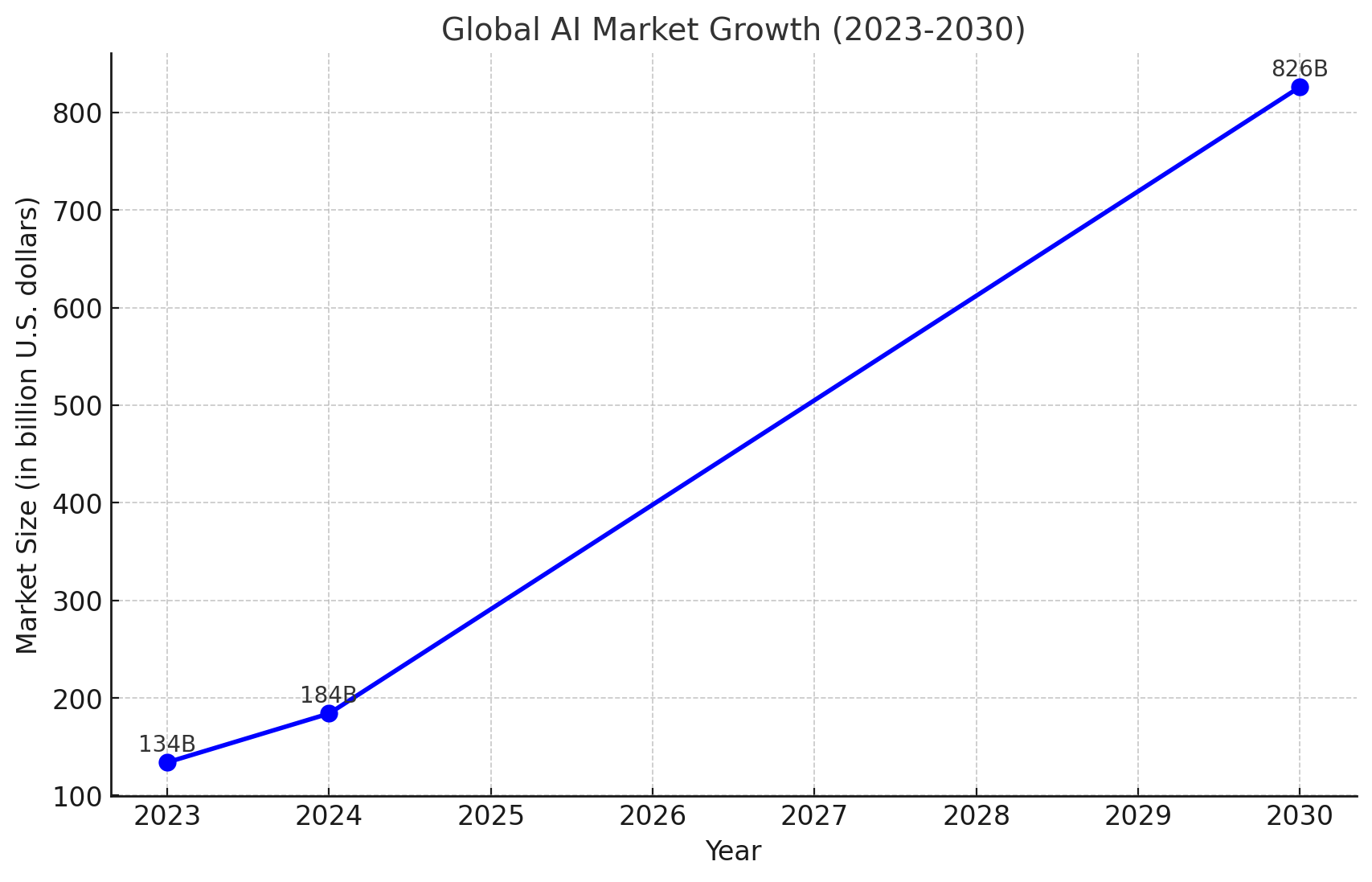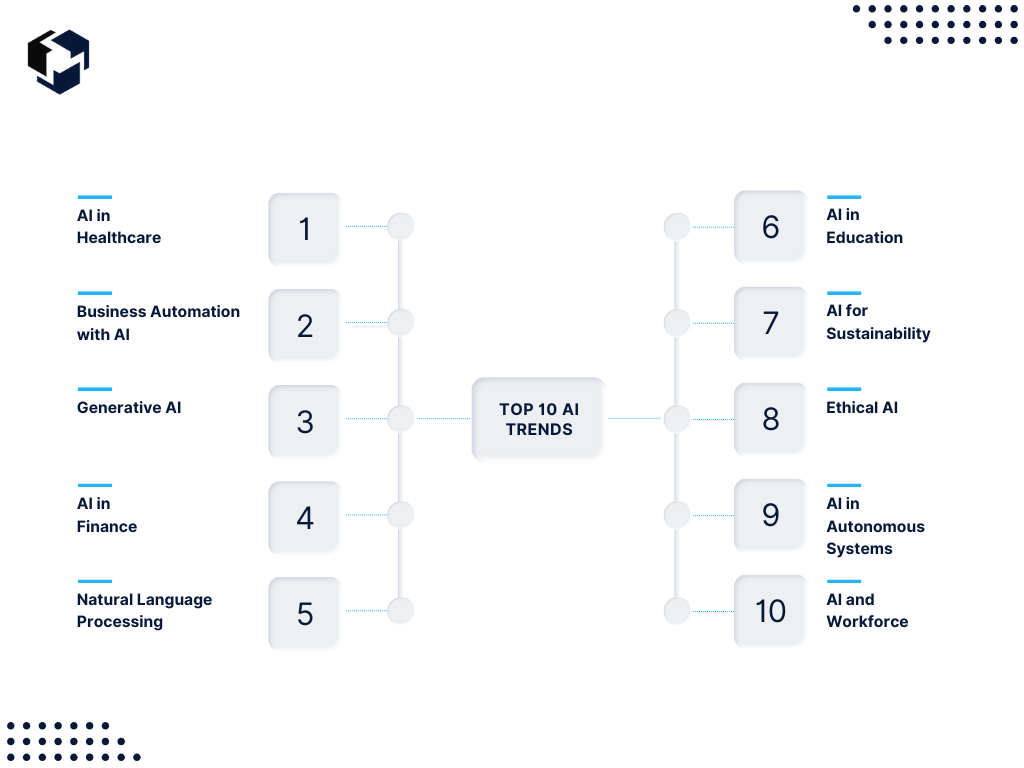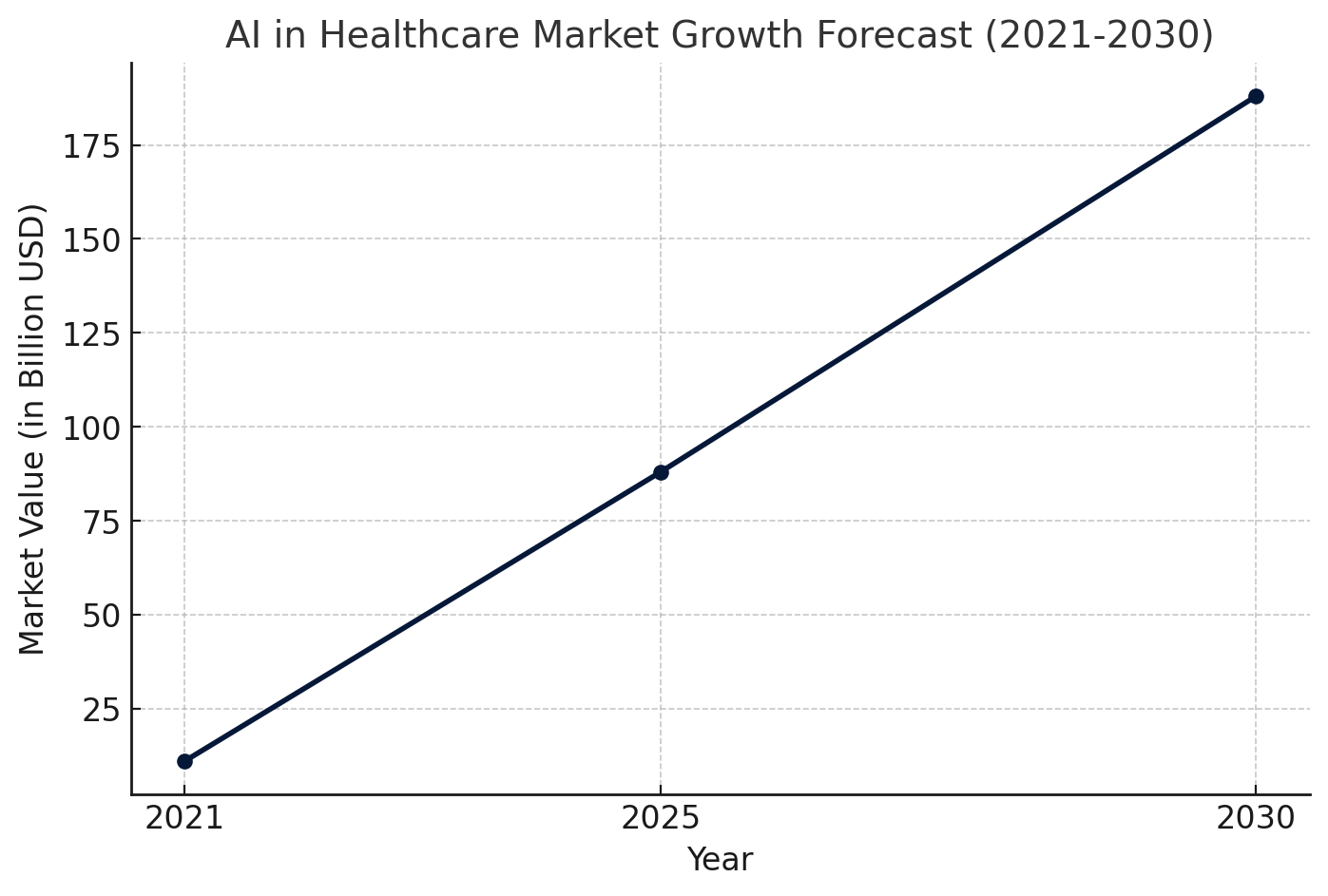Top 10 AI Trends in 2024 & Beyond
AI is the technology of the future that is revolutionizing industries globally and changing the ways by which tasks are accomplished. It ranges from automating processes to changing the face of patient care altogether. With any progressing technology comes opportunity through various industries ranging from healthcare all the way to finance and sustainability.
The AI market was 173 billion U.S. dollars in 2023 and had a significant increase in 2024, and it will be 826 billion U.S. dollars in 2030. This fast pace of growth is due to the increased usage of AI, and hence its use is becoming a necessity in business to remain relevant and innovative.

Partnering with an AI development company ensures businesses stay competitive with tailored solutions that drive innovation and efficiency.
In this blog, let’s discuss the top 10 trends that will define the future of AI in 2024 and beyond. These developments suggest future directions for AI, which can be viewed as a chance to improve performance, imagination, and eco-friendliness of operations. Keep on reading to find out how these trends can reshape your business model.

1. AI in Healthcare: Bettering the Quality of Life of Patients and Hospital Functioning
AI is revolutionizing healthcare through diagnosis, treatment, and administrative processes. With an increasingly complex world of healthcare, AI delivers more effective, precise, and client-oriented treatment. Market data from Statista shows that the AI healthcare market was more than 11 billion USD in 2021, while the forecasts represent growth to 188 billion USD in 2030, proving the constant integration of AI solutions and their further significance.

AI-Driven Diagnostics, Imaging, and Predictive Analytics
Advanced algorithms within minutes interpret medical images, laboratory tests, and patient records to diagnose diseases including cancer, heart disease, and neurological disorders. In the next level, predictive analytics also predict complications and allow for preventive treatment and improved patient results.
AI in Remote Monitoring and Telemedicine
In this setup, AI relies on the analysis of the vital real-time signs of a patient, where it detects any irregularity and notifies the professional care givers to take appropriate action. Its benefit lies in increasing the availability of health care facilities common in underprivileged communities and the ability to constantly observe without readmissions.
Effects on Cost, Patients’ Satisfaction, and Organization’s Performance
AI allows for cutting out overhead costs inherent in most organization due to efficient automation of the organizational processes. Automated scheduling and workflow help with productivity and increase time for patient care for providers. This leads to reduced overall charges, quick delivery of services as well as improved patient satisfaction.
Revolutionize your healthcare operations with Artificial Intelligence. Get in touch with us to help you to unleash new ideas to deliver improved results.
2. Business Automation with AI: Boosting Efficiency and Reducing Costs
By 2024, business automation is becoming more common in industries where artificial intelligence takes charge of operations and generates insights. Beginning with supply chain to customer service, it eliminates steps and therefore cutting on costs.
Optimizing Supply Chain, Logistics, and Workforce Management
Using AI, demand is predicted, stocks are controlled, and delivery schedules are found. Innovative tools of analysis and artificial intelligence make predictions of disruptions, control over routine processes, and real-time changes in the distribution of staff.
AI-Powered Customer Service
Chatbots and virtual assistants offer round the clock customer support, are capable of answering frequently asked questions and also reduce response time. These systems deal with considerable amount of customers’ information, provide them with individual offers, and relieve people from routine work.
Tangible Benefits
The application of AI in business leads to the decrease in organizational costs, increases in efficiency of the decision-making process and management of resources. AI algorithms work on large sets of data and present more information in order to make decisions quickly and more effectively thus presenting a competitive advantage.
Case Study: Intranet Portal with Generative AI
An immense oil & gas corporation was experiencing problems in the exchange of information and documents with partners and vendors. To tackle these, we created an ‘AI-Powered Partner Portal’ that is an intranet solution to enhance effectiveness and interaction.
Results:
- Less paper handling due to the implementation of document automation.
- Quicker search results and other related features such as autosuggestions.
- Better communication between the partners, the vendors, and the company.
- Reducing procurement and supply chain risks, and enhancing outcomes by using artificial intelligence.
This case shows that generative AI is not only helpful in creative activities but also in operational and collaboration ones.
Explore the full case study here: Intranet Portal with Generative AI.
3. Generative AI: Disrupting Creativity and Content Generation
AI is now generative and is changing the creative industries and how art, media, and content are created. It allows the business and the content creators to come up with unique and tailored content at an enormous scale promoting innovation.
AI Applications for Art, Text, Music, and Video Production
Tools like DALL-E and ChatGPT are used to perform creative tasks, creating art, writing content, composing music, and making videos with very little human intervention. These tools are applied in the entertainment, advertising, publishing, and game development industries; they make work easier, cheaper, and more efficient.
The Generative AI in Marketing & Media Production
Marketing departments use generative AI in creating content, advertising, and engaging promotions. AI applications enhance self-employment by automating how the visual effects, music and script of a production are done to meet typical time restraints in production. This creates new opportunities for narrative and interactiveness of the audience.
Intellectual Property and Ethical Issues
The use of generative AI brings to the fore issues to do with Intellectual Property rights and ethics. Since AI develops from existing works, issues of originality, ownership as well as possible bias come up. There is also a threat that information may be misinterpreted, and there are consequences for human authors. It is crucial that existing rules are clear and the practices that stem from them are sensible to avoid abuse of such strong resources and to build people’s confidence in them.
4. AI in Finance: Risk Management and Fraud Prevention Improvement
AI in finance is making it possible to develop new approaches to risk management, fraud detection, and cybersecurity. AI is applied in financial institutions to enhance the efficiency, decision-making, and security of their services and financial products.
Preliminary Analysis Using Artificial Intelligence for Forecasting, Risk Analysis, and Portfolio Analysis
Because of its high accuracy in handling large volumes of data, AI is critical in financial forecasting and risk assessment. Some jobs machine learning algorithms perform include; forecasting market trends, interpreting risk prospects of various investments, and rebalancing investment portfolios to aspects that may not easily be noticed by human beings. It enables institutions to take preventive measures, adapt to the changes, and control risks in order to enhance financial forecasting, property utilization, and investment profitability.
Highly Sophisticated Fraud Detection and Real Time Tracking
Fraud detection is one of the most important applications of artificial intelligence whereby transaction data is analysed for signs of fraud. These models are always changing, and they become better at identifying complex frauds. Real-time monitoring systems perform millions of transactions in quick time and help institutions to act fast against threats minimize losses and retain customer confidence.
Benefits: Improved Security, Reduced Losses, and Better Decision-Making
The use of AI in the healthcare system improves security decreases financial losses and increases the quality of decision making. Applying real-time fraud detection causes a decrease in risks of financial crime situations, and predictive analytics make investment decisions better and adjust to market shifts. AI enhances internal operations, making them more reliable to protect the client’s and other stakeholders’ finances.
5. Natural Language Processing (NLP): Transforming Human-Machine Interactions
NLP is changing the way human interact with machines by making them more natural and personalized. By making computers learn to comprehend, translate, and answer based on human language, it enhances interfaces throughout various markets.
Breakthroughs in AI Chatbots, Virtual Assistants, and Language Models
Due to major developments in NLP, the present chatbots, virtual assistants, and language generation models are able to consider context, emotion, and can have actual conversations. Siri, Alexa, Google Assistant and so on implement commands and offer customized replies for personal and routine chores. Modern examples such as GPT drive chats, answering questions, providing suggestions, and providing round the clock customer support for increased interaction.
Breaking Language Barriers and Automating Communication
An instance of how NLP is used is the removal of language barriers during business operations as the AI-powered translation devices and the use of multilingual chatbots. These systems provide efficient customer service in the languages thus being very important when expanding into other countries. NLP also handles routine text processing work such as responding to emails, generating reports, and extracting data which otherwise would require a lot of human resource time.
6. AI in Education: Enhancing Learning Experiences
AI has taken a toll on education in the following ways: enhancing learning for students and educators and making learning more student-centered. It enhances an individualized approach to learning, increases students’ interest, and encourages diversity.
AI Platforms for Adaptive Learning and Personalized Tutoring
Technology-enhanced learning systems adapt curriculum based on the performance of the students and provide feedback to the students. Computer-assisted tutoring systems are designed to offer on one assistance to students in practice, review, and mastery of subjects at their own level of understanding.
Enhancing Student Engagement with AI-Driven Tools
Feature enhancement with the help of AI in the form of VR, smart games, and quizzes increases student interest and promotes idea assimilation. Instant feedback makes it possible for educators to modify the means used in teaching in order to meet the needs of the students.
The Future of AI-Enabled Classrooms
AI enhances access in that students with disabilities or who are restricted by language can use speech recognition and NLP translation. AI can also identify learning disorders at an early stage to inform the teacher to take necessary action to provide every learner with an individualized learning experience.
Educational Applications: Virtual Tutors & Assistants
Applied to education, NLP revolutionizes the way teaching is delivered through artificial intelligence tutors and teaching assistants. These tools provide instant results, are personalized, and make complex concepts easy to understand. NLP supports educators by grading assignments, summarizing material, and analyzing research data and any other data, which increases efficiency and usability.
7. AI for Sustainability: Driving Climate Action and Resource Management
Climate change and sustainable resource management is an important area where the use of AI is indispensable. It enhances the intelligent usage of energy, lowers emission levels, and increases disaster coping mechanisms.
Energy Efficiency and Carbon Minimization
AI also applies consumption analysis in regulating heating and cooling systems as well as lighting. Sustainability impacts efficiency in production and supply chain, harnesses clean energy technologies, and addresses challenges with energy storage and distribution.
Predictive Analytics for Climate Impact and Disaster Response
Climate change is explained with the help of AI-generated predictive models that assist businesses and governments in adapting to climate change. Satellite data is used by AI in monitoring and forecasting signs of natural disasters, which helps optimise resources and improve infrastructures.
AI in Sustainability Initiatives
AI improves farming by the efficient use of water, crop surveillance, and low use of pesticides. AI is used in energy management and in the integration of renewable energy into smart grids by energy companies. For instance, Google applied AI to decrease its data centers ‘energy usage by 40%. AI also helps in traffic management and waste disposal, and the reduction of green house gases in urban areas.
8. Ethical AI: Building Responsible and Fair AI Systems
Accountable AI creation guarantees that the factors related to the AI systems are accurate and reasonable and respect privacy so that everyone can trust AI devices and will not receive undesirable consequences.
AI Governance, Privacy, and Policy Compliance
AI governance guarantees the respect of regulations such as the GDPR and the AI Act that are awaiting enactment. These frameworks safeguard users’ information and guarantee that, while implementing AI, innovations will not violate societal values resulting in user trust.
Mitigating Bias and Discrimination
AI algorithms can be biased, which means that the results will be unfair and will only deepen the existing gaps. To do this, organizations need to gather various data, perform periodic reviews, and use XAI to increase accountability and trust.
Global Standards for Ethical AI
IEEE and OECD are among the global organizations that support a joint focus on human rights and societal benefits frameworks. Adopting these standards helps businesses foster trust and position themselves as leaders in responsible AI.
9. AI in Autonomous Systems: From Self-Driving Cars to Drones
AI drives self-sustaining systems that revolutionize sectors including transport, supply chain and farming, reducing risks, costs, and time.
AI Innovations in Automobiles, UAVs, and Robots
Autonomous systems are systems where the decisions that need to be made, the navigation and the control are made by AI. Self-propelled vehicles rely on machine vision and LASER vision and control systems to decipher their environment and avoid objects. Self-flying drones help to overcome difficult topographies, and artificial intelligence allows robots to accomplish sophisticated operations in production, medicine, and mining.
Logistics, Agriculture, and Public Safety Application
- Logistics and Transportation: Self-driving trucks and drones help to improve supply chains and minimize delivery time and expenses.
- Agriculture: They also fly over fields, scan fields for crop health, investigate the composition of the soil, and apply herbicides in a controlled manner.
- Public Safety: Modern drones with artificial intelligence are used for monitoring, search and rescue operations, and combating natural disasters with accurate situational awareness.
The Future of Autonomous Systems
Self-driving cars and delivery techniques are expected to decrease the number of traffic accidents, lower energy consumption, and revolutionize the transportation and the online shopping business. Yet issues like regulation, acceptance by the public, and loss of employment among them have to be solved for their full utilization.
10. AI and the Future Workforce: Jobs, Skills, and Adaptation
AI is bringing changes into the job market, opening new prospects but becoming a problem for employees. It has become paramount that as these technologies are adopted in business, employees should be trained in order to be able to catch up with these changes.
The Ways in which AI is Transforming Jobs and Skills
AI performs repetitive tasks while generating new positions. It is now common to find that many positions demand a combination of technical competencies and soft skills including technical writing, data analysis, machine learning, AI, creativity, problem-solving, and flexibility. It also creates new occupations among which are AI ethics officers, data scientists, and machine learning engineers. Employees need to acquire other skills that will enable them to operate in the new environment with AI.
The Effects of Automation in Various Fields
Applications of AI automation are already seen in manufacturing, and healthcare, finance industries, and the retail industry. Robots in manufacturing perform complicated operations in assembling tasks with high levels of accuracy. Therefore, the integration of AI in the healthcare sector aims at promoting diagnoses and processing information and patient care. In finance and retail, AI self-services, assist in fraud prevention, and in the management of inventories. As automation increases efficiency, it displaces demand for manual workers to technology-based workers, meaning that the organization must actively manage its workforce to assist the workers affected.
The Future of Reskilling and Upskilling
Employers and political entities should provide targeted education projects for new skills, including digital competencies and basic AI knowledge as well as more sophisticated problem-solving skills. Web-based courses, boot camps, and school collaborations promote lifelong learning. Promoting continuous learning ensures that employees accept change and helps to lower the effects of unemployment in a world where jobs are becoming scarce.
Conclusion
AI is making its way into industries and changing business processes and the job market for the better. The top 10 Artificial Intelligence trends for 2024 in health, finance, education, sustainability, and more show the extent to which AI is already changing our world.
The key to Growth is to keep up with, keep ahead of, and become masters of AI Applications.
Are you prepared to discover how AI can help solve your business problems? Schedule a Call today for tailored solutions to enhance your organization.
The advancement in AI is continuous. AI will persistently reinvent industries as new technologies are developed – enhancing accessibility, sustainability, and process efficiency. Companies that will engage in these opportunities will be the leading companies in the future through innovation, productivity, and sustainability.
FAQs
What are the Key Trends Shaping AI in 2024 and Beyond?
The top trends include AI in healthcare, business automation, generative AI, AI in finance, NLP, AI in education, sustainability, ethical AI, autonomous systems, and AI’s impact on the workforce.
How is AI Revolutionizing Healthcare?
AI enhances diagnostics, personalizes treatments, streamlines administrative processes, and improves patient care through telemonitoring and telemedicine.
What are the Benefits of AI-powered Business Automation?
AI automation reduces operational costs, streamlines supply chains, enhances workforce management, and improves customer service with chatbots and virtual assistants.
What Role does AI Play in Reshaping the Job Market?
AI automates routine tasks, creates new roles (like AI ethics officers and data scientists), and drives demand for reskilling and upskilling to adapt to new technologies.
How can Businesses Benefit from Partnering with an AI Development Company?
Partnering with an AI development company ensures access to tailored AI solutions, helping businesses stay competitive, drive innovation, and improve operational efficiency.




















